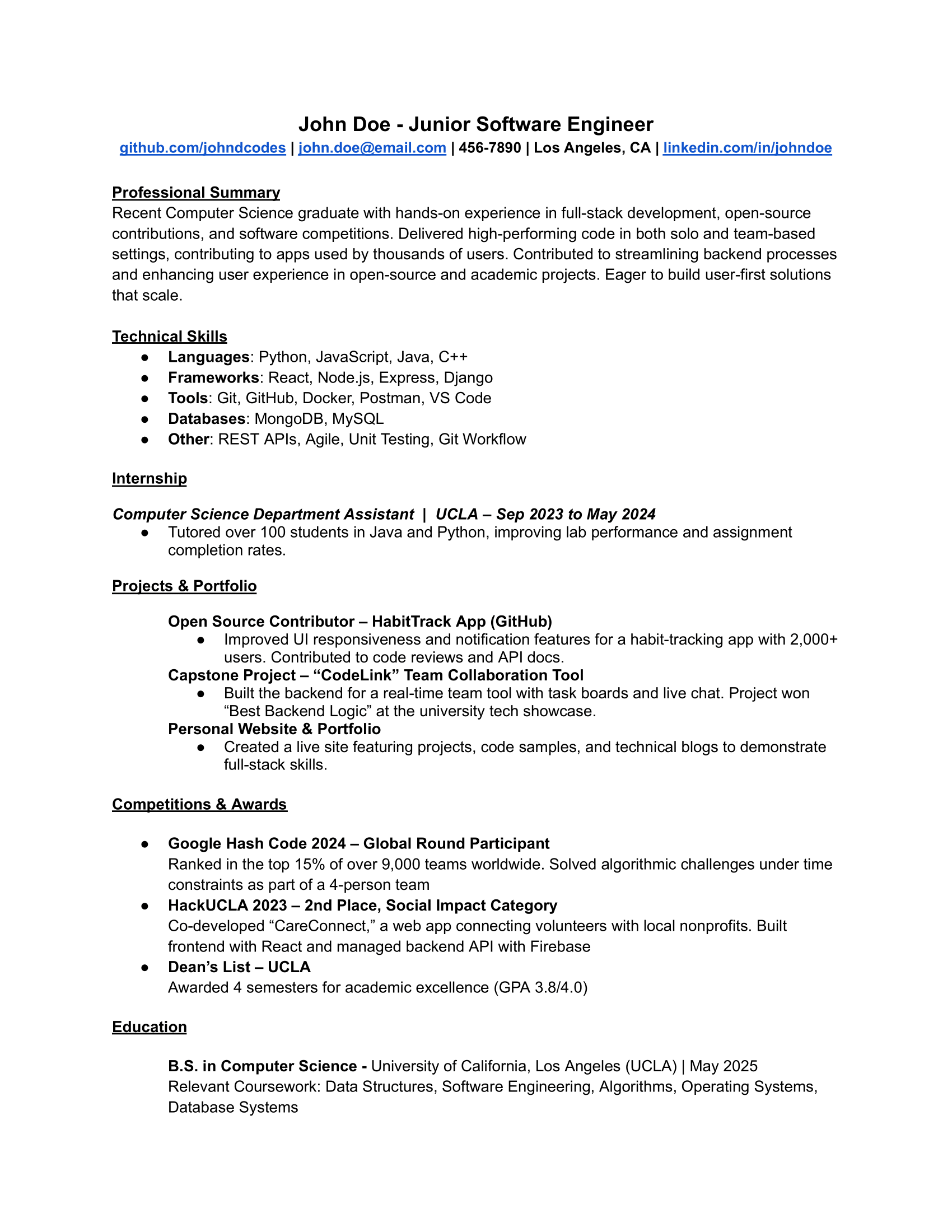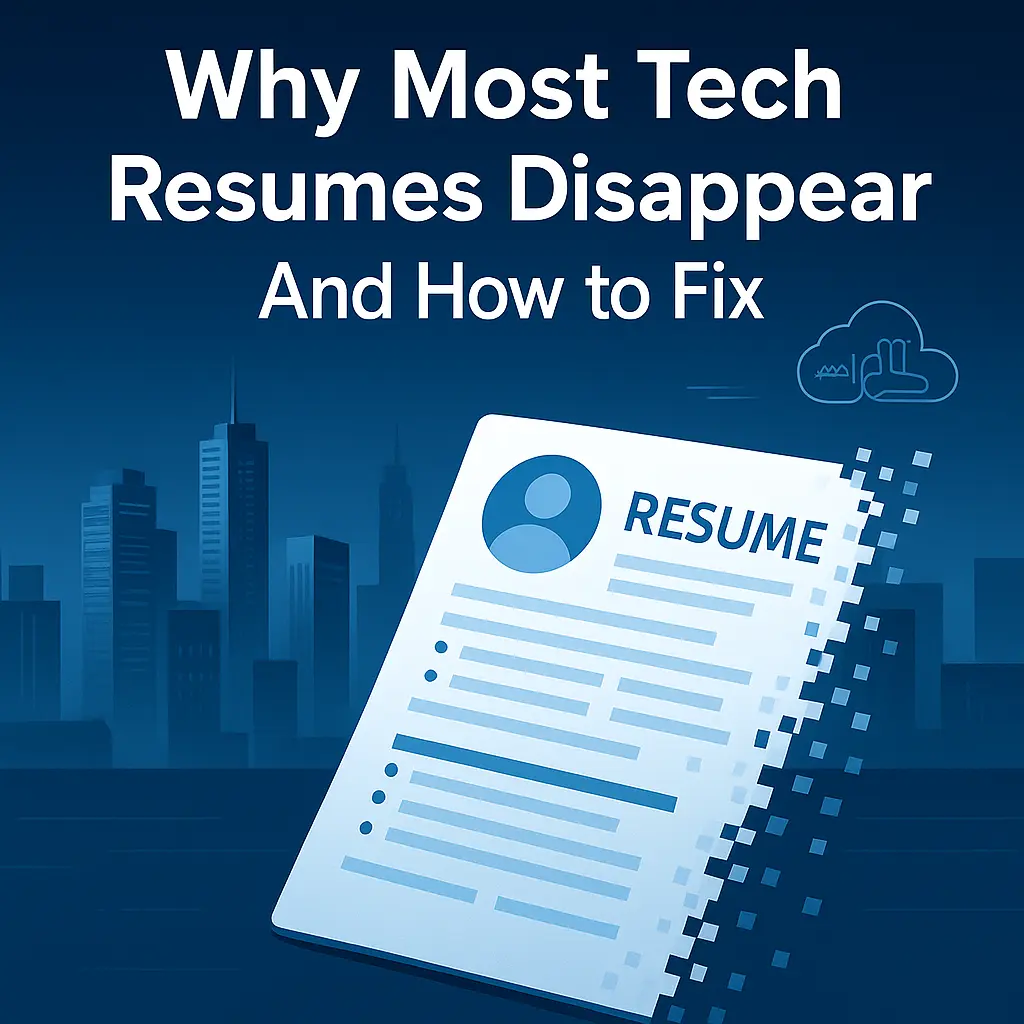Your resume should never be a copy-and-paste job from a template you found online or borrowed from a friend. What works for someone else won't necessarily work for you, especially when you're at a different career stage.
Creating a resume for different career stages means knowing exactly how to showcase your value at any point in your journey.
From students entering the workforce to professionals exploring new industries, this guide offers practical advice tailored to each path.
This isn't just another resume how-to. It's a deep dive into how your resume should evolve as your career grows and shifts, written with insider perspective. Whether you're wondering what to put on your resume as a fresh graduate or how to reframe your experience when switching careers, you're in the right place.
Resume for Entry-level professionals
Entry-level professionals often face unique challenges in their job search. Employers typically seek candidates with strong educational backgrounds or relevant internships.
Breaking into the job market with little to no experience is tough, but it’s not entirely impossible.
Hiring managers understand that early career applicants won't have a long list of roles under their belts. What they want to see is potential, drive, and a genuine understanding of the job they're applying for.
Here’s an example of a Junior Software Engineer’s fresh graduate resume:

Key Sections to Focus On:
- Education: Include your degree, expected graduation date, and any honors or relevant coursework.
- Internships and Practicums: Real-world exposure matters. List any experience in your field, even unpaid.
- Projects and Academic Work: Highlight class projects, presentations, or capstone work that align with your target role.
- Part-Time Jobs and Volunteering: These can show responsibility, leadership, or communication skills.
- Skills and Software Proficiency: Focus on tools and soft skills employers actually look for in entry-level hires.
You might be wondering why most resume writers recommend leaving out your graduation year unless you're a fresh graduate. And why things like honors, extracurricular activities, or school projects often disappear from resumes after a few years in the workforce.
Here’s the truth. It all comes down to relevance.
If you’ve been working for a while, including your graduation year can unintentionally open the door to age bias.
Yes.
Some hiring managers may not even realize they’re doing it, but once they see the year, they start calculating how long ago you graduated.
That shifts their focus from your recent experience and skills to your age or career timeline, which isn’t where you want their attention. Leaving the year off keeps the spotlight on your most current and valuable contributions.
Now,
What about extracurriculars, academic honors, or big school projects?
If you’re just coming out of college, your resume might feel a little thin, and that’s perfectly normal. You’re not expected to have years of work experience yet.
What matters most at this stage?
It’s your potential, and that’s where your academic background, honors, and extracurricular involvement really make a difference.
Including your graduation year helps employers know you’re actively entering the workforce. It shows them you're ready for entry-level roles, internships, or training programs that are specifically geared toward new graduates.
It's useful context and shows your career timeline is just beginning, you’re motivated, coachable, and ready to learn.
The key is to make it relevant. Connect the dots.
Say for example,
If something from your college experience demonstrates a skill or mindset that relates to the job you’re applying for, include it. This is your chance to show what you bring to the table, even if it wasn’t in a traditional workplace.
Also, your resume should evolve with your career.
What made sense when you graduated doesn't always make sense later on.
📌 Feeling lost after graduation? New to the job hunt? Discover remote roles and tailor your resume in minutes. Start your career the smart way.
Resume for Mid-career professionals
When you’re a few years into your career, employers expect to see growth and increasing responsibility. Your resume should reflect this clearly by focusing on the outcomes you’ve driven, the teams you’ve supported, and the goals you’ve hit.
Your resume should look something like this:
Professional Summary
Software engineer with 6+ years of experience building scalable web applications and modernizing legacy systems, reducing load times by up to 40%. Proficient in Node.js, React, and PostgreSQL. Lead cross-functional teams and deliver stable, user-centric solutions. Actively upskilling in cloud architecture and system design to drive long-term engineering impact and transition into strategic leadership roles, aligning technology initiatives with core business objectives.
Technical Skills
Languages: Python, JavaScript, Java, C++
Frameworks & Libraries: React, Node.js, Express, Django, Next.js
Databases: PostgreSQL, MongoDB, Redis
Tools: Docker, GitHub Actions, Postman, Figma, AWSPractices: Agile, CI/CD, REST APIs, WebSockets, TDD
Work Experience
Software Engineer TechForward Inc. – Los Angeles, CA | January 2019 – Present
- Legacy inventory system was slow and unstable under high traffic; implemented React, PostgreSQL, Node.js and rewrote frontend/backend, reducing load time by 40% and improving uptime.
- Users lacked real-time logistics updates; used Socket.io and Redis pub/sub to build real-time dashboards, boosting dashboard engagement by 25%.
- Onboarding was inefficient; created CI templates and technical docs using GitHub Actions and Confluence, reducing onboarding time by 30%
- Manual QA slowed releases; developed Python and Selenium test suites integrated into CI/CD, cutting QA effort by 60%.
- Clients needed unified insights; used React, Node.js, and MongoDB to build modular dashboards, improving client satisfaction by 18%.
- Notification system failed frequently; rebuilt with AWS SES and cron tracking, resulting in a 45% drop in support tickets.
Certifications & Awards
AWS Certified Developer – Associate (2024)
Google UX Design Certificate – Coursera (2023)
MongoDB for Developers – MongoDB University (2022)
HackUCLA – 2nd Place, Social Impact Track (2023)
Google Hash Code – Top 15% globally
Key Sections to Focus On:
- Professional Summary: Replace the outdated objective with a value-driven summary that reflects your expertise.
- Career Progression: Showcase how you’ve moved up, even if within the same company.
- Metrics and Results: Use numbers backed by real data.
- Certifications and Continuous Learning: Show you’re evolving in your field with courses, workshops, or advanced degrees.
- Leadership and Collaboration: Even if you don’t manage people, projects or initiatives count.
Here comes the tricky part.
You’re six or seven years into your career. Maybe you’ve stayed with the same company, waiting for a promotion that never came.
Maybe you’ve jumped roles hoping something would click, but nothing has felt quite right. Now you’re questioning what’s next.
A new direction? A complete career pivot? Or is this burnout?
Most mid-career professionals are not just looking for another job. They’re often seeking a career change or building a career back-up. And that changes everything about how you write your resume.
Creating a resume for this stage requires clarity, confidence, and a strong sense of direction. You need to show:
- Results, not responsibilities. Focus on what you achieved, improved, built, or led.
- Transferable skills. Connect the dots between your past experience and your future goals.
- Intentional narrative. Your career story should feel cohesive, even if it spans industries or job functions.
If you’re shifting industries or roles, don’t hide it. Own the transition.
Lead with your value and back it up with results. A well-crafted resume at this stage is not just a list of what you’ve done. It’s a pitch for where you’re going next.
📌 Ready for your next leap? Stuck between burnout and your next big break? Customize your resume and find your remote career path here, it’s Free.
Resume Length and Format
If you’re just starting out or fresh out of school, a one-page resume format usually does the trick.
That’s usually enough if you're early in your career or only have a few roles to highlight. But if you’ve been working for a while and have more relevant experience, two pages are totally okay.
The key is relevance.
Okay, let’s clarify this.
You don’t need to include every job you’ve ever had. Focus on the ones that show you’re ready for the role you're applying for.
Why does this matter? Hiring managers don’t read every word. They scan. A clean, focused resume helps them get what they need fast and leaves a better impression.
And who really wants to scan long documents?
Most hiring managers only spend a few seconds on each resume. That’s why your most important information should be at the top, easy to spot, digestible, and quick to scan.
Since the eye naturally moves from left to right, make sure you’re using that space wisely.
As for format, you’ve got a few options:
- A chronological format is great if your career path is steady and within the same field.
- A functional resume works better if you're switching careers or need to highlight transferable skills.
- A hybrid format gives you the best of both. It lets you lead with your strengths while still showing a clear work history.
What about those who have difficulty structuring their resumes?
Use a resume customization tool. Resume writing is a tedious and manual work. Even the most experienced professionals often gets rejected and doesn’t really know how to structure one for their level.
At times underselling their value and costs a missed opportunity.
There’s no perfect formula, but there’s a smart way.
Organizing your resume in a way that brings out your strengths, even if you’re short on experience or coming from another industry. You’ll get insights on what to tweak, how to tailor your resume for each role, and increase your chances of getting interview offers.
Instead of starting from scratch or second-guessing every word, you can focus on the content that really matters.
That’s the edge you have when you employ smart tools on your job hunt.
📌 No shortcuts to success, but a smarter resume gets you there faster. Customize your ticket to success and find remote jobs here.
FAQs About Resume For Entry and Mid Careers
Q1: Should I include a photo on my resume?
No. Photos are generally not included in the U.S. and may cause bias. Photos on resume isn’t advisable.
Q2: What if I have job gaps?
Use a functional or hybrid format and focus on skills or experiences gained during the gap.
Q3: Do I need a different resume for every job?
Yes. Tailoring your resume improves your chances of passing applicant tracking systems.
Q4: Should I list every job I've ever had?
No. Focus on the most relevant roles.
Q6: What if I’ve changed jobs frequently?
Group similar roles together and focus on accomplishments, not tenure.
Q7: Should I include references on my resume?
No. Just note “References available upon request” or omit entirely.
Q8: How long should I keep my GPA on my resume?
Only include it if you’re within 2 years of graduating and it’s above 3.5.
Q9: How often should I update my resume?
Ideally after any major achievement.
Final Thoughts: Tailored Resume Is Always Key
Here’s the thing.
Whether you're an entry-level job seeker or a mid-career professional looking to switch lanes, one thing stays true, a tailored resume is always your best bet.
Crafting a resume for entry-level and mid-career professionals takes more than just plugging your experience into a clean layout. It takes strategy, clarity, and a little self-awareness. You’re not just listing jobs. You’re building a case for why you’re the right person for the next one.
If you’re early in your career, your resume should highlight potential. If you’re mid-career, it should reflect growth, results, and direction. Think less about what you’ve done and more about what matters to the role you're aiming for.
The truth is,
Most job seekers either oversell or undersell themselves. The sweet spot is somewhere in the middle, where your resume tells the right story at the right time for the right audience.
So whether you're writing your very first resume or reworking it after years in the field, take the time to make it count. Tailor it with purpose.
What we highlighted were just samples meant to inspire or guide you. Relevance wins every time. Cut what no longer serves your story. And always keep your next move in mind.
📌 Now’s the time to get clear on what you bring to the table. Position yourself clearly so the right people can say yes. Start opening doors to the roles you actually want.
.svg)


















